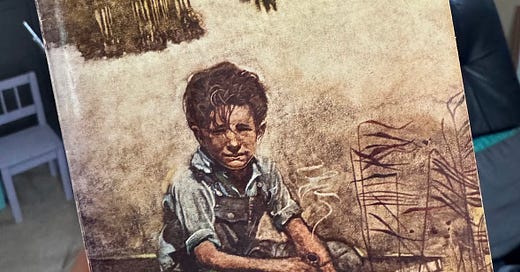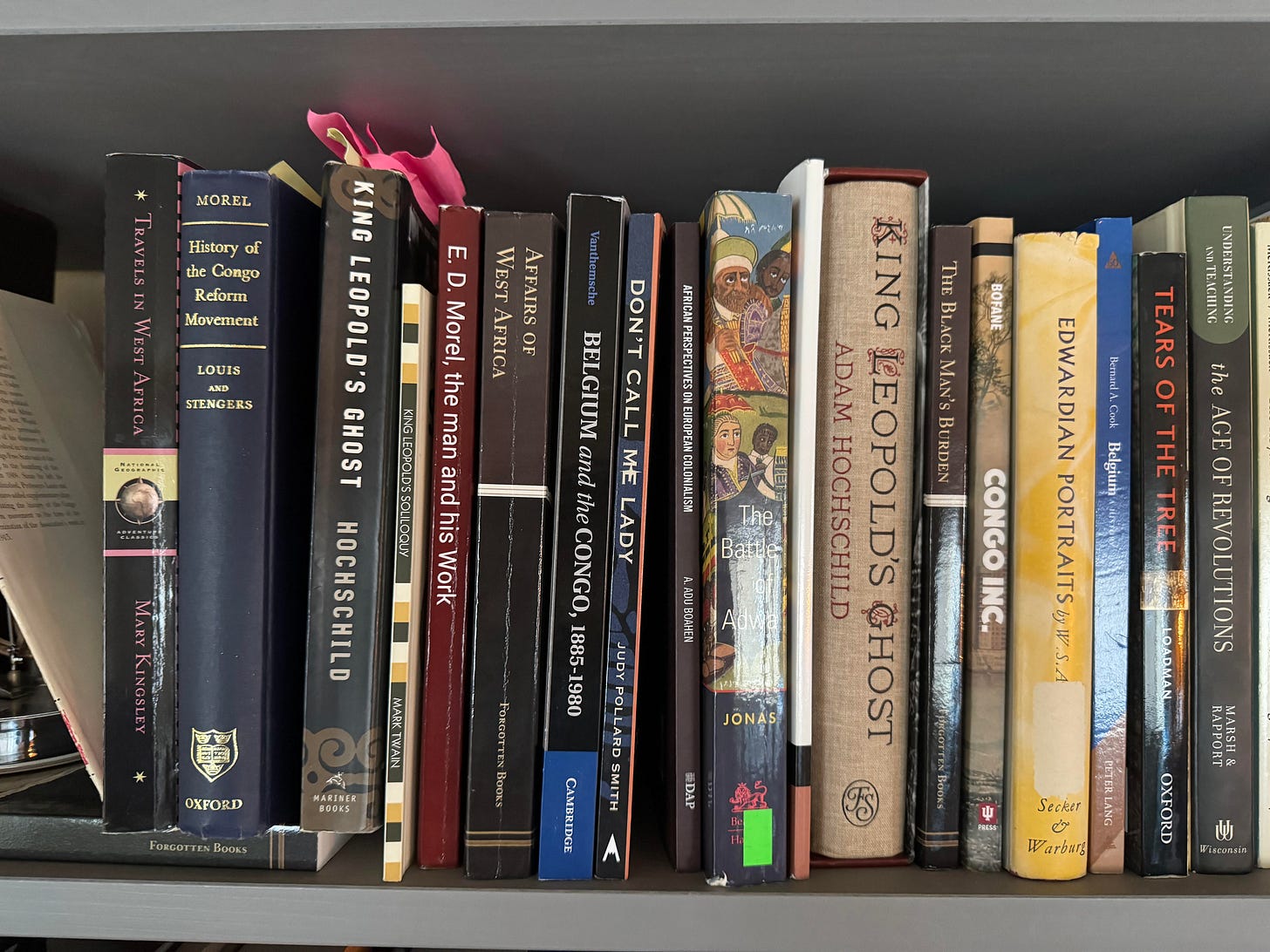Huck Finn and James and King Leopold II
I love Mark Twain so much. He makes my heart float amongst my lungs and livers and such.
Books to read: THE ADVENTURES OF HUCKLEBERRY FINN and JAMES
I didn’t read HUCK FINN in high school. My teacher…
Hi Matt!
***picture me waving enthusiastically***
…gave us the choice to read HUCK FINN or UNCLE TOM’S CABIN. My classmates and I chose the 400+ page tome that started the Civil War instead of reading Mark Twain’s masterpiece because we thought we were smarter than everyone else.
Our teacher, I suspect, thought we made the wrong decision. He made us promise that we’d read HUCK FINN at some point in our lives.
So I read HUCK FINN over Christmas break last week. Not really to fulfill promises made in high school, but because I knew JAMES was wrapped up under the tree for me and I wanted the context of HUCK FINN before diving into the National Book Award winner.
TBH, I thought I would hate it. I’m still recovering from the brain-numbing horrors of reading DAVID COPPERFIELD (so boring) in order to read DEMON COPPERHEAD (so good!), so I thought that having to read HUCK FINN would suck too.
Well dog my cats, it did not suck!
THE ADVENTURES OF HUCKLEBERRY FINN is a total delight.
I’m assuming most of you know this already, because smart, well-read people read this newsletter, so excuse me for being a little late to the party.
I’m also glad that I’m a history teacher and not an ELA teacher because even though I loved reading HUCK FINN, I can see how it would be hard to teach, with all that hard-to-understand dialect and that problematic word that starts with an n being on nearly every page.
As Kate Dusto says, “I spent my first four years in the classroom teaching Adventures of Huckleberry Finn, and it was about as much fun as getting my kids to clean their rooms.” See her newsletter for before-and-after pictures of her kid’s rooms as proof :)
But because I could just enjoy reading HUCK FINN, I did. Immensely. The story (Huck fakes his death to escape his father and floats down the Mississippi with Jim, an enslaved man who has also run away) was great and the characters were delightfully ridiculous. But it was the language that makes the book oh-so-delightful. I kept reading lines to my husband and children, hardly able to get through a sentence because I was laughing so hard. Then my family members would look at me like I was crazy and leave the room. Which was great! More time for me to read! It was a good winter break.
I’m still running around the house telling everyone to knock it off with their tears and flapdoodle.
Exactly one second after finishing Mark Twain, I dove straight into JAMES. I knew that JAMES was a retelling of the story from the perspective of Jim, the enslaved man who’d run away and was floating down the Mississippi with Huck. I always try to avoid reading too much about books I’m planning to read (I usually don’t even glance at the summary on the back), but with a book as big as JAMES, I couldn’t help hearing about how Percival Everett was lauded for giving Jim agency.
While reading HUCK FINN, I naturally zeroed in on every scene with Jim, wondering how Percival Everett would deal with each new plot twist.
WARNING! Spoilers for JAMES and HUCK FINN below!
JAMES was great, of course. The book opens with a mirror image of the first scene in HUCK FINN that involves Jim. In one HUCK FINN scene, Jim is sleeping while Tom and Huck sneak up on him. Tom removes Jim’s hat and places it on a branch above his head.
In JAMES, Jim closes his eyes as “those little bastards” (that would be Tom and Huck) hid in the tall grass, noisily sneaking up on him. Jim always knows exactly what is going on.
As the first chapters of JAMES unfolds, readers learn that Jim and other enslaved people speak two languages: standard American vernacular with each other and “slave speak” in front of White folks. The way that Jim teaches his daughter to speak both languages is chillingly reflective of how Black people today describe having “the talk” with their kids about how to act around the police so they don’t get shot during routine traffic stops.
While the first half of JAMES mirrors HUCK FINN, the second half doesn’t. I wish it did.
Towards the end of HUCK FINN, Jim is captured as a runaway slave. Huck and Tom make grand plans to free him, which are totally ridiculous. The White folks in the book aren’t really keeping much of an eye on Jim, so he could easily run away. However, Tom wants to make a grand spectacle out of the escape. He (and a skeptical Huck) cajole Jim into doing all kinds of things prisoners do in books, like throw messages out of windows and tame spiders as pets. Tom and Huck bake a cake with a knife in it and feel the need to saw the legs off of Jim’s bed (and eat the sawdust) to release the chains when they could have just easily lifted the bedstead off the ground. By the time they give Jim the okay to escape, the whole town is on high alert (due to the “nonnamous letter” Tom wrote, warning that trouble was brewing), and they barely made it out alive.
Jim in the book JAMES wouldn’t have stood for any of that flapdoodle, so I was very excited to see how Percival Everett was going to spin the scene.
He doesn’t. The ending is way different. I mean, it’s good…just not the ending in HUCK FINN.
Okay, spoilers over. Are you back? Don’t worry if you accidentally read that. There is still loads of stuff that happens in JAMES that I didn’t write about.
A place to explore: The Mississippi River
I’ve never floated down the Mississippi, although I did once go to a minor league baseball game right on the river in Davenport, Iowa. Go Quad City River Bandits!
For all your Mississippi River reading needs, may I suggest River Time: Mississippi River Dispatch from the Quapaw Canoe Company:
A lesson to teach: KING LEOPOLD’S SOLILOQUY
I should have known that I’d like HUCK FINN. After all, the main thing I knew about Mark Twain was what I’d read in my favorite nonfiction book ever, KING LEOPOLD’S GHOST, which is a book about how King Leopold orchestrated genocide in his personal colony of Congo in the late 1800s in order to become the wealthiest man in the world. In the book’s introduction, author Adam Hochschild writes about how he had no idea about Congolese killing grounds in the late 1800s until he read a footnote: “The footnote was to a quotation by Mark Twain, written, the note said, when he was part of the worldwide movement against slave labor in the Congo, a practice that had taken five to eight million lives. Worldwide movement? Five to eight million lives? I was startled…Why were these deaths not mentioned in the standard litany of our century’s horrors? And why had I never before heard of them?”
Adam Hochschild goes on to write the story of King Leopold’s greed, duplicity, and genocide. My newsletter about KING LEOPOLD’S GHOST, along with links to my full unit plan for teaching about European resistance in Africa is right here, should you need it.
But back to Mark Twain. He was one of several people railing against the King and trying to get the world to listen so someone would take the colony away from the mass-murdering monarch. KING LEOPOLD’S SOLILOQUY is a satirical pamphlet that depicts King Leopold reading all the critical things people are saying about him and scoffing. TBH, it’s not fine literature in the way that HUCK FINN is, but if you are obsessed with the people who hate King Leopold (as I am), then it’s a must-read.
If you want a quick taste of the pamphlet, you can read the same two pages I have my students read, on this document here.
The work I have my students do focuses on five of the people who brought down the King. Students read/analyze primary source excerpts from the folks below. The link above provides a Google doc that includes the student assignment, the primary source, a bit about each person, and a link to find more online (where available). It takes my students 3-4 days (we have 60-minute periods)
Primary sources are from:
Mark Twain
E.D. Morel: He was a freelance journalist and shipping clerk who worked for the shipping company that King Leopold used. He dug through trade statistics to prove that slavery was happening in the Congo and then quit his job to spend the next decade writing scathing indictments against the King. Also, my favorite historical figure.
Roger Casement: He traveled to Congo, recorded the atrocities he saw and then teamed up with Morel to bring down the King
George Washington Williams: He traveled to Congo, was appalled, and wrote an Open Letter to the King which everyone ignored because he was Black
Alice Seely Harris: She went to Congo as a missionary with her husband. Once there, she was horrified at how King Leopold’s men treated the Congolese. Nobody would listen to her complaints, so she started taking photographs to document the horrors of Congo. Once back in Europe, she teamed up with E. D. Morel. His words and her photographs finally convinced the world that King Leopold was up to no good. Her photography was used in Mark Twain’s KING LEOPOLD’S SOLILOQUY, even though Twain didn’t get her credit or even cite her. Grrr.
One more thing: I’m writing a historical fiction book about E. D. Morel. I’m currently 78K words into my second draft and hopeful that I’ll finish the draft by the end of January. For my editing plan, I’m going through the #amwriting 2025 Winter Blueprint Challenge: 10 weeks of podcasts, editing tasks, and zoom co-working sessions as we go through Jennie Nash’s Blueprint book and workbook. If you are a writer and want to also go through the Blueprint Challenge, I have a few gift subscriptions to give away. Send me a message and I’ll get you signed up!
A final Mark Twain quote about writing a book:
“there ain’t nothing more to write about, and I am rotten glad of it, because if I’d ‘a’ knowed what a trouble it was to make a book I wouldn’t ‘a’ tackled it, and ain’t a-going to no more.”
Happy teaching, traveling, and reading! See y’all next Sunday.
Affiliate book links in this newsletter are through Bookshop, a book-buying platform that gives independent bookstores tools to compete online and maintain their presence in local communities. If you purchase books via the links in this newsletter, you’ll are financially supporting me AND your local independent book store, so thank you!









Fun fact! I worked at the Mark Twain House for a summer in college. Very haunted, very fun.
Twain's very brief stint as a soldier in the Confederate army during the Civil War as a young man put him off war as a solution to issues. "King Leopold's Soliloquy" and the similar "War Prayer" were his satirical reactions to warmongering.